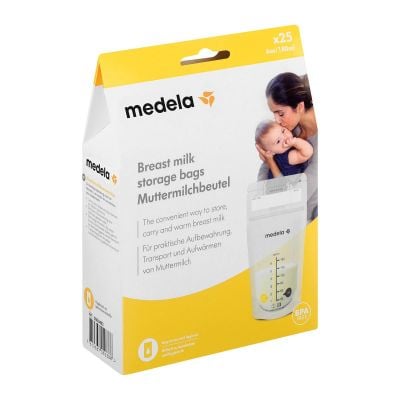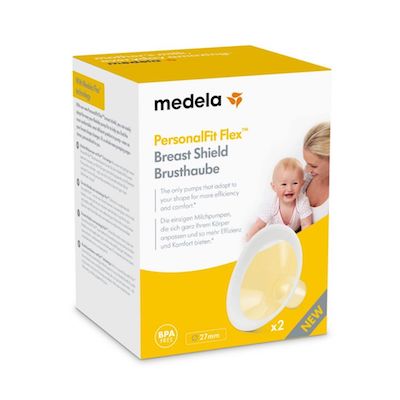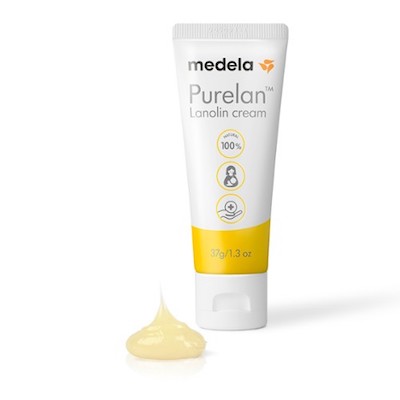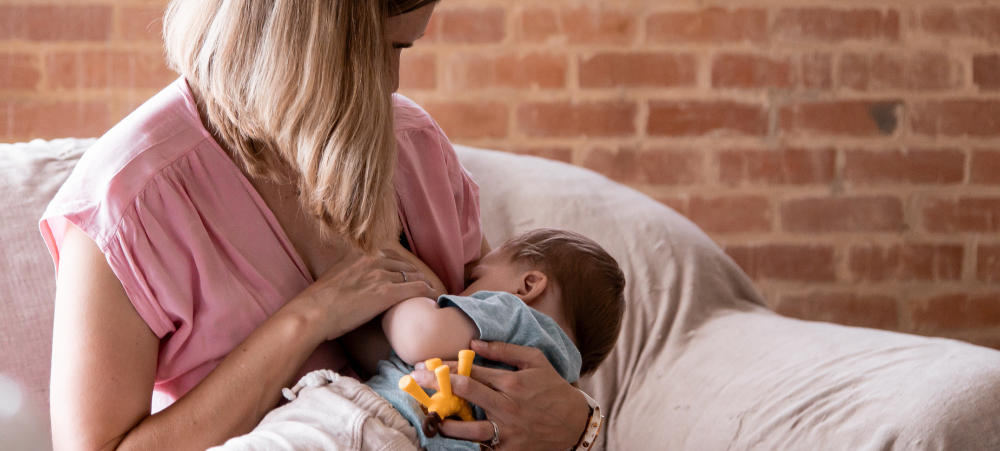Learning how to use a breast pump can take time and dedication, but is well worth the effort. Read our expert breast pumping tips to help set you on the path to successful expressing.
Like any skill worth having, it might take you a bit of time to get the hang of using a breast pump. The key is to be patient, even if you’re not able to express as much as you’d like right away. After all, a breast pump won’t stimulate the same feelings in you as your baby does. But, with time, your body will usually learn to trigger your let-down reflex when you pump, and the quantity of milk you express should increase.
1: There’s no need to rush to start pumping…
In the first four weeks, you and your baby work together to initiate and build your milk supply. If your baby is healthy and breastfeeding is going well, you won’t need a pump to help with this. Pumping is, however, really helpful if you need to be apart from your baby any time (see tip below). If not, enjoy this time with your baby and be reassured that even if you plan to pump regularly in future, there’s no need to ‘train’ your body to express milk in the first few weeks.
2: …unless your baby is unable to breastfeed
If your baby can’t feed directly from the breast, perhaps because she’s premature or has special needs, or you are separated for any reason, start double pumping breast milk as soon as you can after the birth.
Research shows that starting to express within the first few hours (when a healthy newborn would usually have her first breastfeed) helps mums produce a higher volume of milk in the early days and weeks,1,2 giving their babies the best chance of being fed exclusively on mother’s milk.
If you’re expecting your baby (or babies) to be born pre-term, in need of intensive care, or to have a condition that might make breastfeeding difficult, prepare yourself. Contact Lorraine at [email protected] or 011 445 3300 for advice about breastfeeding or book a full consultation with her online at www.medela.co.za to help you choose the right equipment to prepare yourself for special feeding conditions.
There will probably be a hospital-grade double breast pump at your hospital or birth facility, so ask staff to show you how to use it. It’s important to remove milk from your breasts whenever your baby would normally drink – this means your breasts will still get the message to make milk. Aim for eight to 10 pumping sessions every 24 hours at first, and continue this frequency once your milk comes in.
3: Time it right
For your first breast-pumping session, express for at least 15 minutes. Don’t worry if you don’t collect much milk at first – regular extra suction should soon stimulate your breasts to produce more milk.
Some mums find pumping one hour after a feed gives the greatest milk yield, others prefer to pump straight after every second feed – try expressing at different times to see when best fits your lifestyle. When you find times that work for you, stick with them so your body gets used to your breast pump use and the extra demand on your milk supply. You may be tempted to extend the time between expressions in a bid to collect larger volumes of milk. However, if you wait until your breasts are full one pumping session won’t drain them very well, so the key is to pump frequently and regularly.
4: Be hygienic
Always wash your hands before and after breast pumping, and clean any pump parts that have been in contact with your milk or your baby’s mouth. You will also need to sanitise them after cleaning at least once a day. Be sure to allow all the pieces to completely dry and you can then store the pump set in a clear bag or container until next use.
5: Be prepared
To avoid interrupting your breast-pumping session, have everything you need close by before you start. You might want a drink and snack, your phone or TV remote, bottles or milk storage bags for your expressed milk, and a muslin cloth to soak up any drips.

Try the Medela Milk Storage Bags for a convenient way to store, carry and warm expressed breast milk. They have a double zip protection and double walls to ensure no leaks, and the heat-sealed seams guarantee no tearing, splitting or cracking.
A specially designed breast pumping bra allows you to keep your hands free, making it much easier to operate the controls and do other things while you express.
6: Make yourself comfortable
The best position for pumping is one in which you feel at ease. Being relaxed is essential for the release of the hormone oxytocin, which stimulates your let-down reflex. Discomfort and distractions can hamper this process, so choose somewhere private and comfortable, and make sure your arms and back are well supported as you pump.
If you’re not using a pumping bra, hold your breast shield between your thumb and index finger, and use your palm and other fingers to support your breast. Hold the breast shield gently against the breast – pressing too hard could compress your breast tissue and obstruct milk flow.

Medela’s PersonalFit™ Breast shields play a key role in pumping comfort and efficiency. Shields are available in different sizes and is shaped around you so you can easily adjust the way your breast shield fits to find the most comfortable pumping position.
Some mums find deep breathing, soothing music, visualisation techniques, or having their partner massage their back and shoulders, can help them express more milk.
7: Kick-start your let down
Most Medela electric and battery-operated breast pumps have 2-Phase Expression technology, which mimics the way your baby feeds (with fast, light sucking followed by slower and stronger sucks), to help trigger your let down. Massaging your breasts before and during pumping, as well as warming your breasts by applying a warm compress (such as a flannel) on them before expressing has been shown to help stimulate your milk flow and increase the amount you collect.
Scientists have discovered that having skin-to-skin contact with your baby before and during pumping can help you express more milk too. This is because the warmth and touch of your baby’s skin against yours releases oxytocin in your body. In fact, some mums find expressing works best if they feed their baby from the other breast while they pump because of the extra stimulation.
If your baby isn’t with you, try looking at a photo or video of her, or smelling an item of her clothing, while you express. Being able to connect with your baby at the same time as pumping is another way to raise your oxytocin level and help get your milk flowing.
8: Take advantage of your milk flow
Many mothers don’t sense their let down, so watch out for it as you pump. When you start to see jets of breast milk squirting into the collection bottle or bag, you’ll know it’s happening.
If you’re using a breast pump with 2-Phase Expression technology, it will have a stimulation mode and an expression mode. The stimulation mode normally lasts about two minutes, but once you see milk flowing as described, it’s important to switch to the expression phase. This is because that first let down typically provides around 36% of the milk volume, so you’ll be taking advantage of your flow to collect more milk. Let us help you choose the right pump for you, visit www.medela.co.za or contact Lorraine at [email protected] for advice.
9: Find your comfort zone
During the expression phase, pump at your maximum comfort vacuum, which is the highest breast pump setting you can use while remaining comfortable. In research, this was found to remove a similar amount of milk as a baby does during breastfeeding.
To find the right level for you, increase the breast pump suction gradually until it becomes slightly uncomfortable, and then turn it down a notch.
10: Tailor the length of your pumping sessions
Once your supply is established (after about four to six weeks), you can start tailoring how many minutes you need to pump for, which can save you valuable time. Some mothers need to pump longer than others due to their number of let downs, which determine how often and how long milk flows. What’s really amazing is that while every mum has a unique flow pattern, yours will be the same each time you pump as well as when you breastfeed.
So how can you tell what your pattern is? Pick a time when you normally pump your highest volume of milk and watch while you pump, noting when jets of milk start coming from your nipple, or when milk drips into the container over the course of the session.
A mum who only has let downs early in a session will have removed most of her milk within eight to 10 minutes, and pumping any longer won’t reward her with more milk. Conversely, a mum who has many or late let downs may need to pump for 15 minutes or longer to drain her breast thoroughly.
11: Double up
If you’re planning to pump regularly, it’s well worth investing in a double breast pump. Double pumping raises the level of prolactin, the milk-producing hormone, in your body. Amazingly, research has shown that women who double pump have an additional let down in each pumping session. This means they typically express almost a fifth more milk, and milk with a higher fat content too, as opposed to pumping from each breast in turn. This can really add up, in addition to saving time, after just a few pumping sessions you could have an extra bottle.
12: Don’t ignore discomfort
Pumping breast milk shouldn’t hurt. If you feel discomfort while expressing, or notice blisters or chafing on your nipple or breast, try reducing the breast pump suction.

Use Medela’sPurelan Lanolin Nipple Cream to restore the skin’s natural moisture balance and to keep the skin supple. Purelan is safe for your baby that it doesn’t need to be removed before breastfeeding.
Also make sure you’re using the right size of breast shield (the funnel-shaped part that fits over your breast). The breast shield tunnel should surround your nipple closely, but leave enough space for it to move back and forth freely without rubbing. It shouldn’t chafe or pull too much of your areola (the dark area around the nipple), or the breast skin around it, into the tunnel as you pump. A badly fitting breast shield can reduce the amount of milk you express, which is why Medela makes breast shields in several different sizes.
If the discomfort continues after you’ve tried these tips, stop pumping and ask a lactation consultant or breastfeeding specialist for advice.
References
Parker L et al. Optimal Time to Initiate Breast Milk Expression in Mothers Delivering Extremely Premature Infants. FASEB Journal. 2017;31(1 Supplement):650-19.
Parker LA et al. Effect of early breast milk expression on milk volume and timing of lactogenesis stage II among mothers of very low birth weight infants: a pilot study. J Perinatol. 2012;32(3):205.
Kent JC et al. Principles for maintaining or increasing breast milk production. J Obstet Gynecol Neonatal Nurs. 2012;41(1):114-21.
Prime DK et al. Dynamics of milk removal during simultaneous breast expression in women. Breastf Med. 2012;7(2):100-6.
Ueda T et al. Influence of psychological stress on suckling-induced pulsatile oxytocin release. Obstet Gynecol. 1994 Aug;84(2):259-62.
Jones E et al. A randomised controlled trial to compare methods of milk expression after preterm delivery. Arch Dis Child Fetal Neonatal Ed. 2001;85(2):F91-5.
Yiğit F et al. Does warming the breasts affect the amount of breastmilk production? Breastfeed Med. 2012;7(6):487-8.
Acuña-Muga J et al. Volume of milk obtained in relation to location and circumstances of expression in mothers of very low birth weight infants. J Hum Lact. 2014;30(1):41-6.
Vittner D et al. Increase in Oxytocin From Skin-to-Skin Contact Enhances Development of Parent-Infant Relationship. Biol Res Nurs. 2018;20(1):54-62.
Keith DR et al. The Effect of music-based listening interventions on the volume, fat content, and caloric content of breast milk–Produced by mothers of premature and critically ill infants. Adv Neonatal Care. 2012;12(2):112-9.
Prime DK et al. Comparison of the patterns of milk ejection during repeated breast expression sessions in women. Breastfeed Med. 2011;6(4):183-90.
Kent JC et al. Response of breasts to different stimulation patterns of an electric breast pump. J Hum Lact. 2003;19(2):179-86.
Kent JC et al. Importance of vacuum for breastmilk expression. Breastfeed Med. 2008;3(1):11-9.
Kent JC et al. Volume and frequency of breastfeedings and fat content of breast milk throughout the day. Pediatrics. 2006;117(3):e387-95.
Kent JC et al. Principles for maintaining or increasing breast milk production. J Obstet Gynecol Neonatal Nurs. 2012;41(1):114-21.
Gardner H et al. Milk ejection patterns: an intra-individual comparison of breastfeeding and pumping. BMC Pregnancy Childbirth. 2015;15(1):156.
Hill PD et al. The effect of sequential and simultaneous breast pumping on milk volume and prolactin levels: a pilot study. J Hum Lact. 1996 Sep;12(3):193-9.
Prime DK et al. Simultaneous breast expression in breastfeeding women is more efficacious than sequential breast expression. Breastfeed Med. 2012;7(6):442-7.
- A Comprehensive Guide to Medela Breast Pumps - September 3, 2024
- How to store, freeze and thaw breast milk - August 16, 2024
- How to use a Medela breast pump: 12 top tips - August 1, 2024






6 thoughts on “How to use a breast pump: 12 top tips”
this is an interesting read!
Thank you for this! New to Medela and breastfeeding and pumping. Excited to start my journey in a few weeks!
Good Luck ❤️
This is such an useful article! Definitely going to follow these tips once I start pumping! Thank you!
Definitely needed this today as I’m preparing a stash as I go back to work next week.
Enjoyed this article, can relate